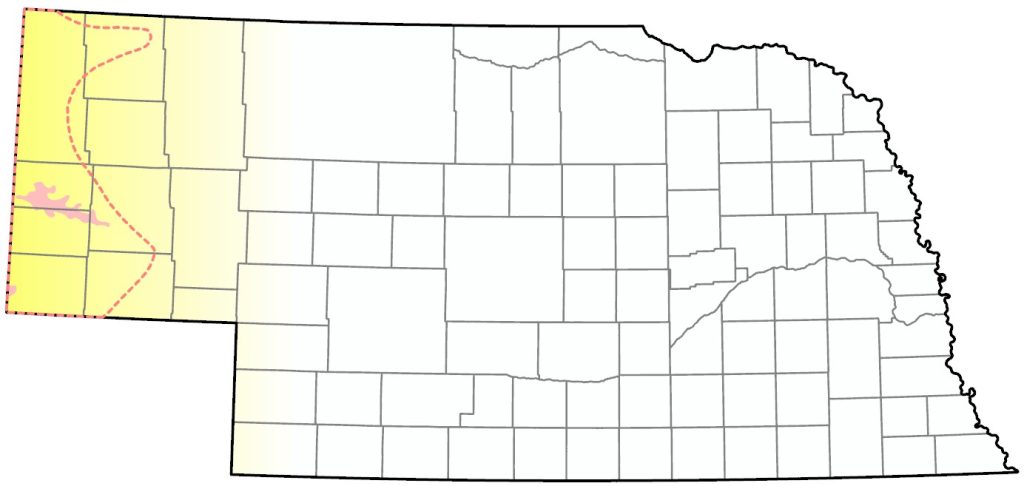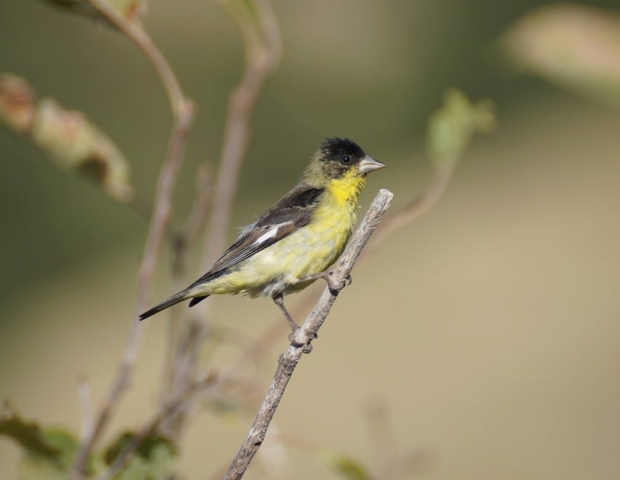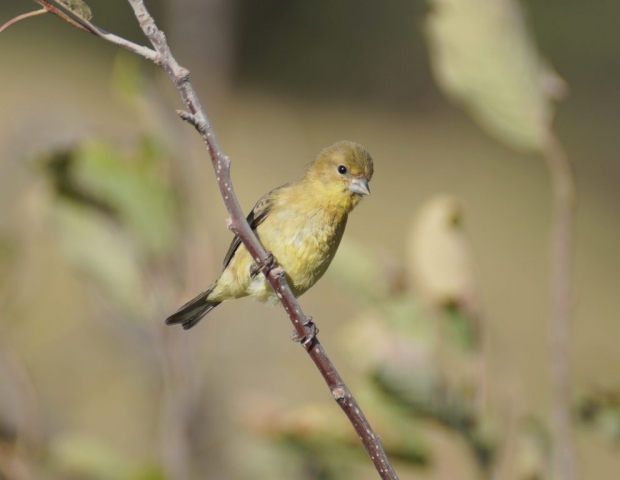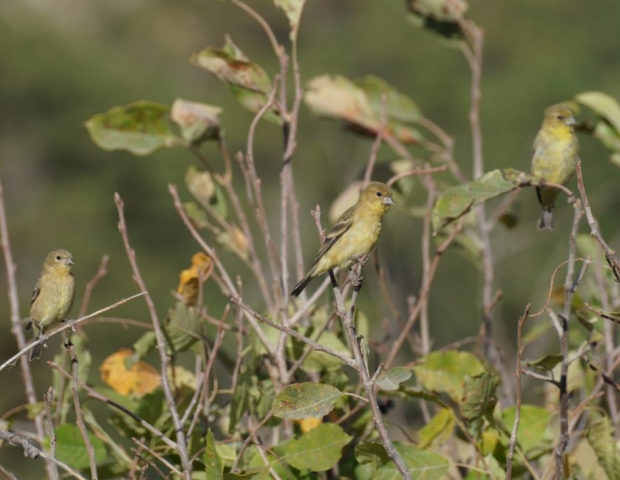Spinus psaltria psaltria, P. p. hesperophilus
Status: Uncommon regular summer visitor Panhandle, rare casual elsewhere. Rare casual breeder Panhandle. Rare casual winter visitor statewide.
Documentation: Photograph: 20 May 1984 Monroe Canyon, Sioux Co (Swanson 1984, Williams, 1984).
Taxonomy: Spinus, a former sub-genus of Carduelis, was raised to generic status based on genetic data (Chesser et al 2009).
Five subspecies are recognized (Watt and Willoughby 2020, AviList 2025), two breeding north of Mexico: eastern psaltria, breeding and wintering from eastern Colorado and western Oklahoma south to southern Mexico (northern populations are partly migratory), and western hesperophilus, breeding and wintering from southwest Washington east to northeast Utah and south to Baja California Sur and southern Sonora.
Recent opinion (AviList 2025, Watt and Willoughby 2020) maintains the two traditional (AOU 1957) subspecies separately while noting that “most” western males (hesperophilus) have green backs, and “most” eastern males (psaltria) have black backs (females do not differ in coloration), and that variation of dorsal color is consistent with a simple genetic polymorphism, although the color types exhibit “markedly different” molt and breeding phenologies (Willoughby 2007, Watt and Willoughby 2020). The Rocky Mountains and Sierra Madre Occidental constitute a region of clinal transition between the two subspecies in the United States, and intermediate back colors occur there (Watt and Willoughby 2014). Farther east, into Colorado, New Mexico, and Texas, an increasing percentage of males have the dorsum and auriculars black and the ventrum brighter yellow (Watt and Willoughby 2020).
Taxonomic confusion can largely be attributed to the fact that the type specimen of nominate psaltria happens to be a green-backed male from Colorado, where black-backed males are presumed to be more numerous (Watt and Willoughby 2020).
In Nebraska, Kansas, and South Dakota, black-backed and green-backed males occur in roughly equal numbers (Tallman et al 2002, Thompson et al 2011).
Changes since 2000: The first state record was in 1984, but of numerous records since then only six were prior to 2000. The species is expanding its range northward in eastern Colorado and continues to increase its numbers in Nebraska; 45 were banded at Wildcat Hills NC, Scotts Bluff Co Sep-10 Oct 2011 and 96 were counted there 26 Aug-8 Oct 2015. Recent breeding records and increased sightings indicate the species is rapidly establishing itself as a summer resident in the Wildcat Hills. We expect the species will continue to increase in numbers and expand its range in western Nebraska.
Summer: May 5, 5, 7 <<<>>> Oct 8, 8, 9
Earlier dates are 7 Mar 2022 (2) Cheyenne Co, 15 Mar 2008 Scotts Bluff Co, 18 Mar 2020 Kimball Co, 18 Mar 2022 Rock Creek SRA, Dundy Co, 18 Mar 2022 (2) Parks, Dundy Co, 1 Apr 2015 (photo) Lake McConaughy, Keith Co, 2 Apr 2022 Lincoln Co, 11 Apr 2020 Scotts Bluff Co, 12 Apr-24 May 2023 Wildcat Hills NC, Scotts Bluff Co, 28 Apr 2008 Scotts Bluff Co, 28 Apr 2020 Adams Co, 1 May 2021 Greenwood Cemetery, Cheyenne Co, and 1-4 May 2020 Scotts Bluff Co.
Later dates are 17 Oct 2022 Gering Cemetery, Scotts Bluff Co, 18 Oct 2008 Scotts Bluff Co, 21 Oct 2018 Wildcat Hills NC, 22 Oct 2022 (3) Wildcat Hills NC, 24 Oct 2020 Scotts Bluff Co, and 28 Oct 2024 Lake Ogallala, Keith Co. 18 were banded at Wildcat Hills NC 8 Oct 2015.
Reports east of the core southern Panhandle range are 28 Apr 2020 Adams Co, 20-21 May 2009 (photo) Elkhorn, Douglas Co (Brogie 2009), 4 Jun 1998 Lake Ogallala, Keith Co (Brown and Brown 2001), 2 Jul 2024 Lake Ogallala, and 28 Oct 2024 Lake Ogallala, as well as four reports at Crescent Lake NWR, Garden Co, 24 May 2007, 25 May-9 Jun 2008, one photographed 27-29 May 2010 (Brogie 2011), 12 Jun 2009, and 2 Sep 2020.
The first Nebraska record of Lesser Goldfinch was as recent as 1984, apparently part of a northward expansion along the foothills of eastern Colorado. There were two more records through 1998, and since then reports have been annual except for 2001-2003. The first three records were 20 May 1984 (cited above), 1 Jun-7 Jul 1986 Crawford, Dawes Co (Cortelyou 1986, Mollhoff 1987), and 9 Jul 1988 Carter Canyon, Scotts Bluff Co (Kenitz 1988). Numbers remained low until 2008, when the six reports totaling 17 birds were described as “an amazing showing” (Silcock 2008). Since 2008, numbers have increased rapidly throughout the western Panhandle; 45 were banded at Wildcat Hills NC Sep-10 Oct 2011, and 96 there 26 Aug-8 Oct 2015.
Nebraska’s first breeding record was of an adult pair apparently feeding at least one young bird inside a bush at Wright’s Gap, northeast Banner Co, 19 Jun 2010; the young bird was not visible but could be heard “cheeping” (Silcock 2010; Mollhoff 2022). At this same location in 2007, a pair was accompanied by an apparent begging juvenile capable of flight, indicating it could have been hatched somewhere else. In 2014 two males and a non-flight-capable fledgling were in Carter Canyon 23 Aug in an area where the species had been observed in previous years. Nesting occurred in the campground at Wildcat Hills SRA, Scotts Bluff Co in 2018 (Kathy DeLara, personal communication). A female “still in breeding condition” was banded at Wildcat Hills NC 26 Aug 2015. A pair with two juveniles was at East Ash Creek, Dawes Co 28 Jun 2022, and nest building was observed 10 Jul 2022 in Long Canyon, Banner Co.
The first Pine Ridge reports were 7-16 Aug 2012 and 24 Sep 2013 in Sioux Co, but solid evidence of northward expansion came in 2017 and 2018: a green-backed male and female were photographed at Fort Robinson, Dawes Co 3-4 Aug 2017, two birds were well-studied in Harrison, Sioux Co 21 Aug 2017, four were reported at a Chadron, Dawes Co feeder 8 Jun 2018, one at Fort Robinson, Dawes Co 26 Aug 2018, and one in Dawes Co 2-3 Sep 2018. One was in Dawes Co 12 Jul 2019, reports in 2020 were 23 Jun and 6 Jul in Sioux Co, and one was at Fort Robinson SP, Dawes Co 27 Aug 2021. In 2022, one was at Chadron, Dawes Co 21 Jun.
In fall 2020 good numbers were reported, almost all at or near Wildcat Hills NC in Scotts Bluff Co and at Exit 1 on I-80 in Kimball Co. Best counts in fall 2020 were at Exit 1, 18-20 on 29 Aug-1 Sep, and around Wildcat Hills NC, best count was 11 on Old Stage Road 25 Aug.
- High counts: 18-20 in Kimball Co 29 Aug-1 Sep 2020, 14 in Banner Co 3 Sep 2019, 10 near I80, Kimball Co 17 Aug 2024, and 9 at Exit 1 on I-80, Kimball Co 18 Jul 2024.
Winter: The 17 accepted records Nov-Feb are scattered across the state. In the west, a male was at a Scottsbluff, Scotts Bluff Co feeder 19 Feb 2008, and one was reported without details at a Morrill, Scotts Bluff Co feeder 13 Jan 2002 by an experienced observer. A green-backed male was in Keith Co 14 Dec 2019. One in a Lincoln Co yard 18 Jan-17 Feb 2018 was photographed, and another was photographed in a different Lincoln Co yard 16 Feb 2018. An extraordinary record, both for location and date, was of a green-backed male photographed attending a Murray, Cass Co feeder from around 26 Nov 2016 through 14 Jan 2017. Perhaps even more extraordinary, almost certainly the same bird returned 6 Nov 2017, but the saga continued as this bird apparently had continued at the same feeder 4-7 May 2018 with Pine Siskins. A bird with a black cap and greenish back “probably” this species was near Gibbon, Buffalo Co 16 Nov 1996 (Silcock 1996). In winter 2020-2021, there were three reports: one was near Gering, Scotts Bluff Co 20 Dec, 1-2 at an Ogallala, Keith Co feeder Jan, and one at a Morrill Co feeder 9 Jan. A pair was at a Buffalo Co feeder 19-20 Jan 2023, and probably one of these was there 24 Mar 2023. In winter 2023-2024, two were at Carter Canyon, Scotts Bluff Co 29 Dec-3 Jan, and a male and female at LeMoyne, Keith Co 30 Jan.
The species’ breeding range has expanded north beginning around from 1995, with overwintering now (2024) occurring in Colorado (Willoughby and Watt 2020) and numerous records on the Great Plains east of the Rocky Mountains (eBird.org, accessed Dec 2023).
Images
Abbreviations
NC: Nature Center
NWR: National Wildlife Refuge
SP: State Park
SRA: State Recreation Area
Literature Cited
American Ornithologists’ Union [AOU]. 1957. The AOU Check-list of North American birds, 5th ed. Port City Press, Baltimore, Maryland, USA.
AviList Core Team, 2025. AviList: The Global Avian Checklist, v2025. https://doi.org/10.2173/avilist.v2025.
Brogie, M.A. 2009. 2009 (21st) Report of the NOU Records Committee. NBR 77: 160-168.
Brogie, M.A. 2011. 2010 (22nd) Report of the NOU Records Committee. NBR 79: 99-111.
Brown, C.R., and M.B. Brown. 2001. Birds of the Cedar Point Biological Station. Occasional Papers of the Cedar Point Biological Station, No. 1.
Chesser, T., R.C. Banks, F.K. Barker, C. Cicero, J.L. Dunn, A.W. Kratter, I.J. Lovette, P.C. Rasmussen, J.V. Remsen, Jr., J.D. Rising, D.F. Stotz, and K. Winker. 2009. Fiftieth Supplement to the American Ornithologists’ Union Check-List of North American Birds. Auk 126: 705-714. https://doi.org/10.1525/auk.2009.8709.
Cortelyou, R.G. 1986. 1986 (Sixty-first) Spring Occurrence Report. NBR 54: 46-64.
Kenitz, A. 1988. Lesser Goldfinch in Scotts Bluff County. NBR 56: 82-83.
Mollhoff, W.J. 1987. First report of the NOU Records Committee. NBR 55: 79-85.
Mollhoff, W.J. 2022. Nest records of Nebraska birds. Nebraska Ornithologists’ Union Occasional Paper Number 9.
Silcock, W.R. 1996. Fall Field Report, August-November 1996. NBR 64: 106-129.
Silcock, W.R. 2008. Fall Field Report, August-November 2008. NBR 76: 134-154.
Silcock, W.R. 2010. Summer Field Report, June-July 2010. NBR 78: 86-102.
Swanson, P. 1984. Lesser Goldfinch reported in Nebraska. NBR 52: 42.
Tallman, D.A., Swanson, D.L., and J.S. Palmer. 2002. Birds of South Dakota. Midstates/Quality Quick Print, Aberdeen, South Dakota, USA.
Thompson, M.C., C.A. Ely, B. Gress, C. Otte, S.T. Patti, D. Seibel, and E.A. Young. 2011. Birds of Kansas. University Press of Kansas, Lawrence, Kansas, USA.
Watt, D.J. and E.J. Willoughby. 2020. Lesser Goldfinch (Spinus psaltria), version 1.0. In Birds of the World (A. F. Poole, Editor). Cornell Lab of Ornithology, Ithaca, NY, USA. https://doi.org/10.2173/bow.lesgol.01.
Williams, F. 1984. Southern Great Plains Region. American Birds 38: 929-931.
Willoughby, E. J. 2007. Geographic variation in color, measurements, and molt of the Lesser Goldfinch in North America does not support subspecific designation. Condor 109: 419-436.
Recommended Citation
Silcock, W.R., and J.G. Jorgensen. 2025. Lesser Goldfinch (Spinus psaltria). In Birds of Nebraska — Online. www.BirdsofNebraska.org
Birds of Nebraska – Online
Updated 22 Jul 2025, map updated 15 Jul 2022



